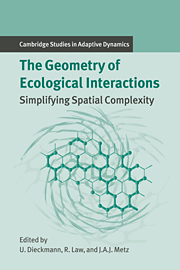Book contents
- Frontmatter
- Contents
- Contributing Authors
- 1 Introduction
- Part A Empirical and Statistical Background: A Plant Ecological Perspective
- Part B When the Mean-field Approximation Breaks Down
- Part C Simplifying Spatial Complexity: Examples
- Part D Simplifying Spatial Complexity: Techniques
- Introduction to Part D
- 18 Pair Approximations for Lattice-based Ecological Models
- 19 Pair Approximations for Different Spatial Geometries
- 20 Moment Methods for Ecological Processes in Continuous Space
- 21 Relaxation Projections and the Method of Moments
- 22 Methods for Reaction–Diffusion Models
- 23 The Dynamics of Invasion Waves
- 24 Epilogue
- References
- Index
- International Institute for Applied Systems Analysis
22 - Methods for Reaction–Diffusion Models
Published online by Cambridge University Press: 14 January 2010
- Frontmatter
- Contents
- Contributing Authors
- 1 Introduction
- Part A Empirical and Statistical Background: A Plant Ecological Perspective
- Part B When the Mean-field Approximation Breaks Down
- Part C Simplifying Spatial Complexity: Examples
- Part D Simplifying Spatial Complexity: Techniques
- Introduction to Part D
- 18 Pair Approximations for Lattice-based Ecological Models
- 19 Pair Approximations for Different Spatial Geometries
- 20 Moment Methods for Ecological Processes in Continuous Space
- 21 Relaxation Projections and the Method of Moments
- 22 Methods for Reaction–Diffusion Models
- 23 The Dynamics of Invasion Waves
- 24 Epilogue
- References
- Index
- International Institute for Applied Systems Analysis
Summary
Introduction
In the classical literature of theoretical biology, most models were based on the assumption that the effects of physical space could be removed by taking spatial averages. This approach has led to various classes of models, of which the most common are ordinary differential equations (ODEs) and difference equations. Yet, probably the most obvious observation is that in nature the distribution of animal and plant species varies greatly in space, even when the spatial environment is fairly uniform. Early investigators were, of course, aware of this fact, but including spatial structure presented problems of considerable technical difficulty. Progress in mathematical techniques means that at least some important questions can be treated theoretically, and others through a combination of theory and computations on the powerful computers now available. A range of techniques, some of them only recently applied to biology, are discussed in this volume. In this chapter we consider the oldest of the major models, for which a large body of theory and well-developed, powerful, computational methods exist. The model is based on a system of so-called reaction–diffusion equations and is one of a class of what may best be described as continuous models.
Continuous models have long been used to treat discrete systems such as gas dynamics. There the behavior of huge numbers of molecules is described by differential equations. Reactions of chemical mixtures have often been modeled using reaction-diffusion equations – that is, systems of nonlinear (technically, parabolic) partial differential equations.
- Type
- Chapter
- Information
- The Geometry of Ecological InteractionsSimplifying Spatial Complexity, pp. 456 - 481Publisher: Cambridge University PressPrint publication year: 2000



